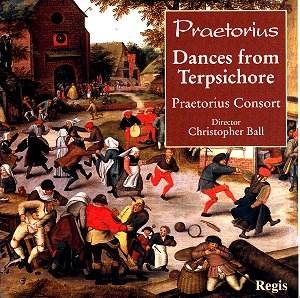According to the reverse of the CD box this recording was originally
issued on a ‘Classics for Pleasure’ LP (no date given). There are 39 tracks
on this CD compared with the mere 21 when issued on CFP. On a little piece
of paper inserted into the booklet we are told that this amounts to an
extra 20 minutes of music. "As a result the whole project is now
from an entirely new master". The excellent booklet notes have likewise
been re-edited by the director Christopher Ball and by Paul Arden-Taylor
one of the wind players.
I don’t have the original LP so I cannot tell you exactly
which pieces are newly available, I do however agree with the original
press reviews that are quoted on the back of the case. Two of them read
"foot-tapping and most appealing"; "Recording crisp and
of demonstration quality". Indeed this disc is not only brilliantly
recorded but fun for all the family as I can personally testify.
Finding it, in the stacks of a CD shop you might like
to remember that the cover only advertises the Praetorius Dances. These
in fact only make up a quarter of the playing time, the Holborne collection
being almost as long. Yet Terpsichore does indeed stand out as the most
memorable music on the disc. The rest, though, is fun and well played.
I’ve often thought it curious that although Terpsichore contains around
300 tunes harmonized in 4, 5 or 6 parts without instrumentation suggestions,
it tends to be the same pieces which are so often recorded. I listened
again to a 1960 LP, the first time Terpsichore was committed to record,
by Collegium Terpsichore (Archiv 14166) and was astonished to find almost
the same collection of dances and with the same colourful and certainly
inauthentic ‘orchestration’ which Christopher Ball also uses many years
later. This even extends to glockenspiel notes on the first beat of
the bar in the Courante and passages for flute and drum and passages
for harpsichord alone. There is no harm in that I suppose, just surprising.
I must say that if I were interested in simply having a CD of these
pieces I would probably go for the Ensemble Musica Antiqua under Christian
Mendoze (Pierre Verany 791041).
Eleven pieces are chosen by Holborne, Queen Elizabeth’s
Gentleman Usher. If I just wanted a recording devoted to Anthony Holborne’s
unwieldy title ‘Pavans, Galliards. Almans and other short both grave
and light, in five parts for viols, violins or other musical wind instruments’
I would go for The Dowland Consort under Jakob Lindberg (Bis CD 469).
It is interesting to make comparisons. The Dowland consort are strings
only, the Praetorius Consort are a (very) mixed consort. Oddly enough
a piece like the soberly named ‘The Night Watch’ works better, it seems
to me, when played in a sprightly manner on recorders, than on viol
consort by the Dowlands. ’It fell on a holy eve’ with its lovely melody,
does not have much of an impact when played as a lute solo on this new
disc but flows beautifully on viol consort.
Arbeau’s ‘Orchesographie’ is a book on dancing and
takes the form of a colloquy between the teacher Arbeau and the pupil
Capriole. The author quotes many dance melodies in all of the available
forms of the time. Ball records nine different types. Some of these
pieces will be familiar to anyone who knows Warlock’s six-movement ‘Capriol
Suite’ for strings, Ball uses five of the melodies found in that work.
Incidentally if you want a recording of the complete music from ‘Orchesographie’
it would be a good idea to look out the ‘New York Renaissance Band’
on Arabesque (Z6514).
The other collections on the CD have to my knowledge
not been recorded before.
But the great joy of this new CD anyway is the fact
that it is possible to compare Praetorius’s famous collection with four
far less famous ones. Demantius is better known as a church music composer.
His arrangements of untitled German and Polish Dances are sober but
noble, and Lambranzi’s short tunes are put into three colourful little
suites. Lambranzi was an Italian dancing master.
Highly recommended, with lively and colourful performances
especially as it is at bargain price.
Gary Higginson


